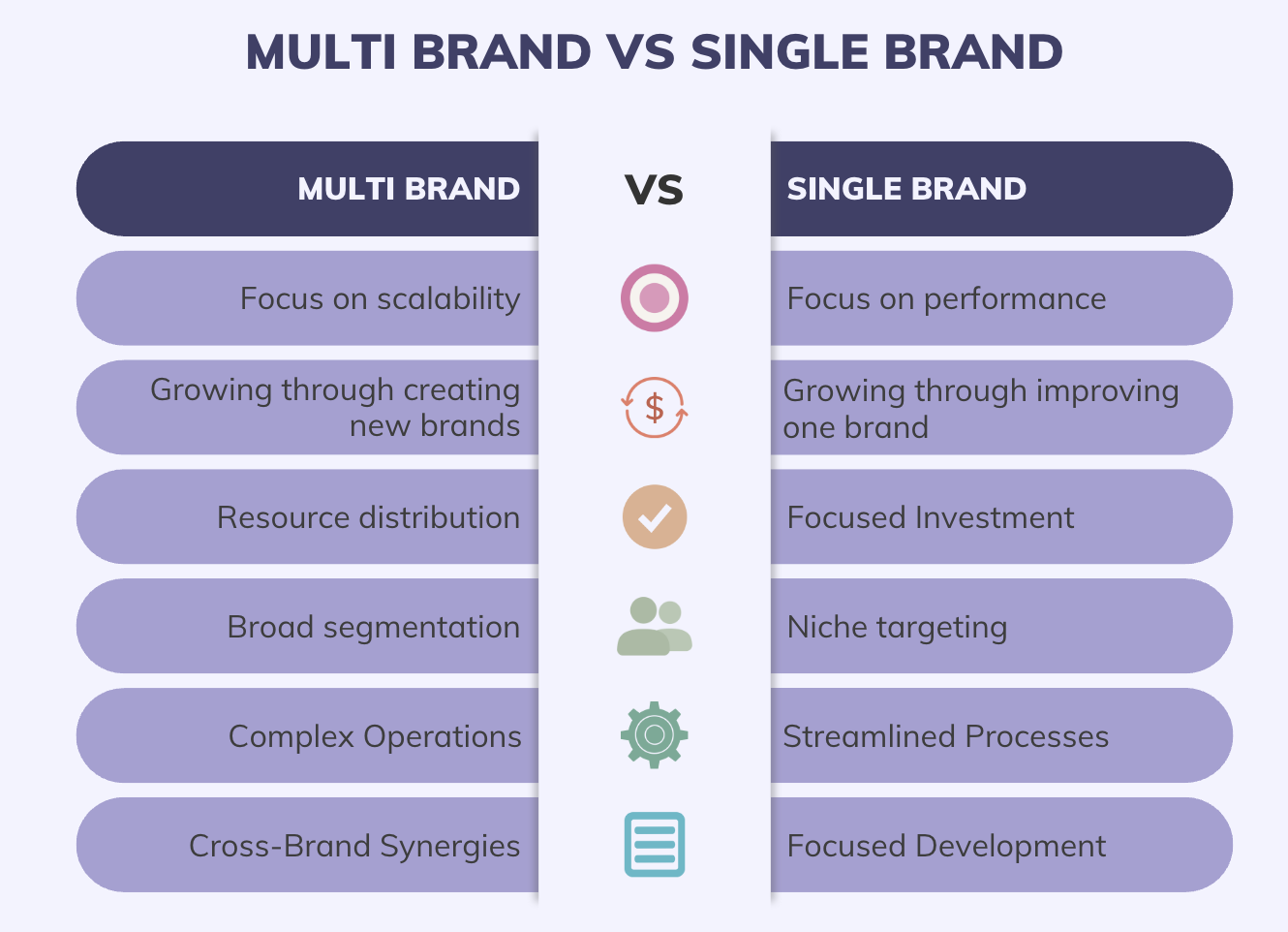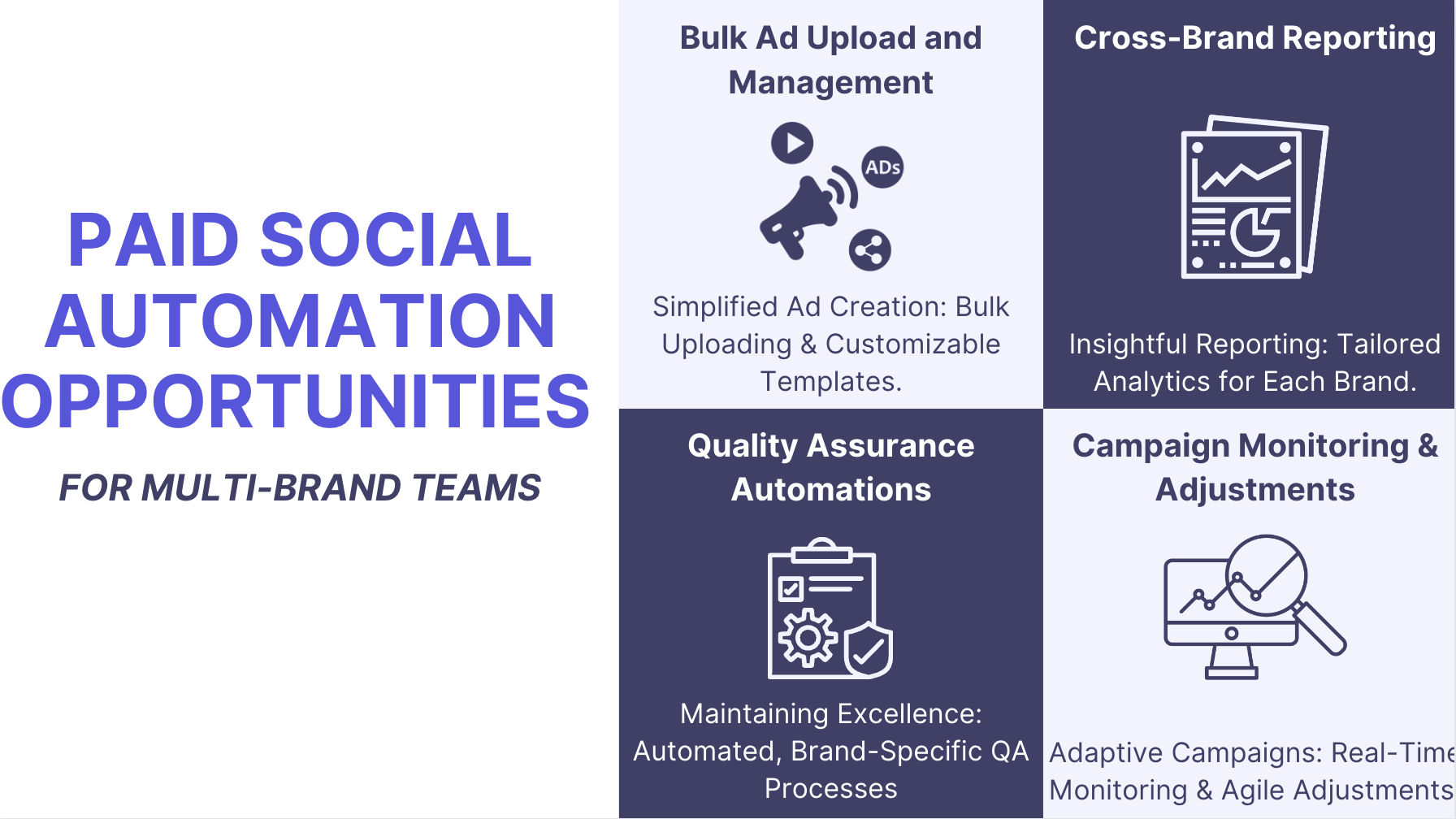Paid Social Blueprints
Paid Social Automation for multi-brand companies
Navigate the complexities of managing paid social ads for multi-brand companies with our in-depth guide. Discover the benefits of standardization and automation, and learn how to implement these strategies for improved efficiency and brand coherence in your paid social campaigns.
Running multiple brands within one paid social team? Managing multiple brands under one umbrella comes with its unique set of challenges and opportunities. Whether your company ventured into the multi-brand strategy by design or through evolution, one thing is clear: standardization and automation are your closest allies in this journey. They not only improve operational efficiency but are key to scaling your efforts—especially in the fast-paced world of paid social advertising.
In this blog post, we will explore the structure of paid social teams within multi-brand companies, delve into the challenges of standardizing processes, and offer actionable insights into implementing standardization and automation effectively.
Why building robust processes is particularly important for multi-brand companies?
Unique business model that focuses on scaling

There are generally two paths that companies take to become multi-brand entities. The first is by design: some companies start with a clear intention of creating an array of products for varied markets. Their goal is to spread risk and diversify their portfolio from the get-go. The second path is evolutionary: a company may start with a single product or brand and expand as it identifies opportunities in different markets.
No matter the journey to becoming a multi-brand company, a common thread runs through all: an emphasis on processes, repeatability, and standardization. This focus allows them to leverage existing infrastructure and operations across multiple brands, making it easier to manage complex operations. Automation is often a key part of this strategy, particularly for activities like ad creation, quality assurance, and reporting.
By efficiently managing their operations, these companies can quickly adapt to market changes and scale their efforts without necessarily scaling their teams. That’s not just smart business, it’s absolutely vital in today’s fast-paced marketing environment.
Unique Structure of Paid Social Teams in Multi-Brand Companies
In the dynamic world of multi-brand companies, the structure of paid social teams takes on a nuanced, yet incredibly significant role. Unlike smaller entities or single-brand companies, these corporations need to craft a team structure that balances both brand specificity and shared expertise.
Multi-brand companies often consist of diverse roles tailored to serve specific functions. At the heart of every brand there is usually Brand Leads. These are individuals deeply invested in understanding a particular brand or market within the company's portfolio. They ensure that the brand's unique voice and strategy align with targeted marketing campaigns.
In addition to brand leads, specialists and consultants form the backbone of the team. They work closely with the brand leads and junior media buyers to offer specialized insights into paid social strategies. Their role becomes even more critical when you’re overseeing 6+ digit monthly budgets or managing multiple ad accounts.
It's crucial to find the right balance between brand-specific strategies and shared resources. One way multi-brand companies achieve this balance is through internal consultations. For example, paid social experts often serve as internal consultants to various brand leads, providing a pool of shared expertise that can be tapped into as needed. This ensures that while each brand receives specialized attention, they also benefit from the broader knowledge and experience within the team.
Paid Social Automation Opportunities for Multi-Brand Team

Bulk Ad Upload and Management
Creating and managing ads and ad creatives is a colossal task, and for teams juggling multiple brands, this task is exponentially more complex due to unique brand blueprints that need to be followed for diverse brands.
Automation can be a total game-changer in this scenario. Envision being able to craft hundreds of ads with a few clicks, using different templates for various brands along with bulk upload features.
Ad templates are central to efficient ad creation, serving as customizable blueprints. They will help you to maintain brand integrity while enabling scalability. With these templates, teams can easily onboard new members and brand on the existing processes, while maintaining the brand identity. The automation of this process with a template library streamlines production, allowing creative teams to focus on strategic initiatives rather than repetitive tasks.

Adopting this solution is crucial not only because it is the domain where most man-hours are spent, but also because it is an area prone to human error. By automating this process, your team can shift their focus from mechanical tasks to the analytical and creative aspects of marketing.
Cross-Brand Reporting
Compiling reports for one brand is demanding, but synthesizing insights from several brands can be overwhelming. When each brand serves a different audience and purpose, a one-size-fits-all reporting method is impossible here. In this case, the team needs a solution that allows them to easily modify the KPIs and tie them to a specific brand or campaign.
An automated solution needs to provide insights in a way that's meaningful to each brand’s specific strategy and objectives, enabling decision-makers to develop strategies that align with the unique business approaches and audiences of each brand.
Quality Assurance Automation
Quality assurance is not just about ticking off checklists in case of multi-brand companies, it's about upholding the integrity of a brand's image. Automated QA processes can be tuned to the specifications of each brand, ensuring that all creatives not only meet general standards but also reflect the specific ethos and compliance requirements of each brand. This type of individualized attention to detail is what differentiates a successful multi-brand strategy from a generic one.

Campaign Monitoring and Adjustments
Each brand within a multi-brand portfolio has its own set of KPIs and performance benchmarks. Automation solutions should be readily adjustable to each brand's unique parameters. For instance, automation can dynamically adjust spending based on brand’s budget, ensuring that every single brand is getting the attention it deserves.
In a multi-brand strategy, it's not just about automating tasks—it's about automating them in a way that respects the distinct identity and business model of each brand, all while benefiting from the scalability and efficiency that automation brings.
Challenges in Standardising and Automating Processes for Multi-brand companies
While the benefits of standardizing processes in multi-brand companies are numerous, the path to achieving this standardization could be very challenging. These hurdles can appear in various forms, from resistance to change within the team to the complexity of coordinating multiple brand strategies. Let’s explore some of these challenges in greater detail.
Risk of Top-Down Assessments
One of the key challenges is the risk associated with top-down assessments. Often, upper management may try to enforce standard processes without having a nuanced understanding of the day-to-day realities of the marketing team. While the intent might be to streamline operations, the risk of these theoretical models not translating into practical efficiency is high. This makes it crucial to involve team members who are involved in daily operations, executing these tasks, in the standardization process.
Navigating Brand-Specific Needs
Each brand in a multi-brand portfolio likely has its own unique customer demographics, market conditions, and even regulatory landscapes. Trying to implement a one-size-fits-all process can compromise the unique strengths and requirements of each brand. Striking a balance between standardization and customization becomes a significant challenge. Processes need to be flexible enough to accommodate brand-specific nuances while still maintaining a degree of standardization for efficiency.
Data Consistency Issues
In an environment with multiple brands, the volume and variety of data can be overwhelming. Different brands may use different metrics or KPIs to measure success, making it difficult to have a single, coherent view of performance. Implementing a standardized data management system can be a significant challenge, but it's crucial for informed decision-making.
Resistance to Change
Changing established processes can be met with resistance, particularly from team members who have been accustomed to a specific way of doing things. Managing this change requires a thoughtful approach, not just in communicating the 'what' but also the 'why' behind these changes. It's a change management exercise that involves much more than just new software or process maps, it involves people.
Standardizing processes for multi-brand companies isn't just about identifying best practices; it's also about consistently implementing these across various brands. By automating repetitive tasks and integrating seamlessly with tools your team already uses, such platforms can significantly smooth the path to standardization.
Implementing Automation
Once you've recognized the challenges and understood the imperatives of standardizing processes in a multi-brand environment, the next step is to strategize its implementation. Here’s how to lay down a robust foundation for rolling out automation and standardization.
Starting Small: One Brand or One Use Case
The most common approach is to start with one brand as a pilot. Initiating with a limited scope allows you to test the waters, evaluate the efficiency of new processes, and make necessary adjustments before rolling it out company-wide. You can start with one specific brand or even a particular use case within a brand to pinpoint the areas that benefit the most from automation and standardization.
Beyond just selecting a single brand, companies can take it one step further by concentrating on a specific use case within that brand. For example, if your team spend most of their time creating ads, it would make sense to start automating ad upload process. By focusing on a particular use case, you have the opportunity to get even more granular with your assessments, isolating variables and making precise refinements before a broader rollout.
Starting with a single brand or use case also helps mitigate risk. Imagine discovering a critical flaw in your automation strategy after you’ve already rolled it out across multiple brands. The financial and operational implications could be severe. A phased approach, beginning with one brand, allows for a more manageable risk profile and the opportunity to fine-tune your strategies before they impact the entire portfolio.
Iterative Adjustments
Once the pilot is up and running, attention turns to evaluation. The key metrics for success aren't just performance indicators like return on ad spend or customer engagement. It’s also about how much more efficient the team becomes and how easily the new processes can scale. Remember, one of the objectives here is to create processes that can be replicated easily across brands, facilitating efficient management of multiple operations.
Initial findings from the pilot brand should inform iterative adjustments. When multibrand companies decide to expand beyond one brand, they usually aim to have several brands in their portfolio. Scaling operations becomes a priority.. The insights gained from the first rollout can serve as a playbook—identifying what works well and what doesn’t, so that when it comes to extending these efforts to other brands, you're not starting from scratch.
People-First Approach
Change is often met with resistance, and it's no different when introducing new processes or automation tools. That's why it's vital to take a people-first approach. Involve team members early in the process and make them a part of the change. When people understand the benefits and have a stake in the outcome, they're far more likely to be champions rather than obstacles.
An integral part of rolling out new processes or platforms is educating the team. Ensure everyone knows not only how to use new systems or follow new procedures but also why it's important. Tools are only as good as the people using them; so, thorough training should be a cornerstone of your strategy.
Conclusion
Implementing automation and standardization across multiple brands is far from simple but, if executed correctly, can set the stage for unprecedented growth and efficiency. By adopting a strategic, step-by-step approach, and utilizing specialized tools, companies can substantially mitigate risks and successfully navigate the complex landscape of multi-brand management.


